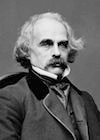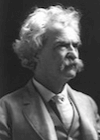
Nathaniel Hawthorne, born on July 4, 1804 in Salem, Massachusetts was an American short story writer and romance novelist who experimented with a broad range of styles and genres. He is best known for his short stories and two widely read novels: The Scarlet Letter (mid-March 1850) and The House of Seven Gables (1851). Along with Herman Melville and Edgar Allan Poe much of Hawthorne's work belongs to the sub-genre of Dark Romanticism, distinguished by an emphasis on human fallibility that gives rise to lapses in judgement that allow even good men and women to drift toward sin and self-destruction. Dark Romantics tends to draw attention to the unintended consequences and complications that arise from well-intended efforts at social reform. Melville dedicated his epic novel, Moby-Dick to Hawthorne: "In token of my admiration for his genius." Hawthorne's lesser-known poems exemplify Dark Romanticism; some of his darkest works, including his ghost stories and tales involving the supernatural, fall within the genre of Gothic Literature.
Young Hawthorne was a contemporary of fellow Transcendalists: Ralph Waldo Emerson, Henry David Thoreau, and Louisa May Alcott, Hawthorne was part of this prominent circle of Massachusetts writers and philosophers. The Transcendentalists believed in the "inherent goodness of both people and nature." I would encourage you to think of them as intellectual hippies of the early 19th century (the movement sprang forth in the 1820s and 1830s). Hawthorne was a founding member of Brook Farm, a utopian experiment in communal living -- though he is not portrayed as a deep believer in its ideals. As Hawthorne matured, he drifted further and further from some of the transcendental principles. In fact, his later writing, produced after greater experience in the world, demonstrated an increasing disdain for the Transcendental Movement. He notably fictionalized the experiences of Brook Farm in his satirical novel The Blithedale Romance (1852).
 I think it's important to mark Hawthorne's migration from a young Transcendental idealist to a Dark Romantic writer. At one level it's a remarkable journey because the older man comes to embrace the opposite inclinations of his youth; that rather then being inherently good, people were deeply fallible, prone to lapses in judgement and they difted easily to sin. Furthermore, some of their greatest sins were committed under the umbrella of good intentions. On another level, the journey is common-place, as almost all individuals discover that the journey of life tempers their youthful idealism. But there is also a personal history the weighed heavily on Hawthorne. He had two stern forefathers in his patrilineal heritage, his great-great-great grandfather and his great-great-grandfather John Hathorne. So he knew well that men could, cloaked in the countenance of goodness and piety, commit great sin. Here is Hawthorne describing them both (starting with the great-great-great grandfather):
I think it's important to mark Hawthorne's migration from a young Transcendental idealist to a Dark Romantic writer. At one level it's a remarkable journey because the older man comes to embrace the opposite inclinations of his youth; that rather then being inherently good, people were deeply fallible, prone to lapses in judgement and they difted easily to sin. Furthermore, some of their greatest sins were committed under the umbrella of good intentions. On another level, the journey is common-place, as almost all individuals discover that the journey of life tempers their youthful idealism. But there is also a personal history the weighed heavily on Hawthorne. He had two stern forefathers in his patrilineal heritage, his great-great-great grandfather and his great-great-grandfather John Hathorne. So he knew well that men could, cloaked in the countenance of goodness and piety, commit great sin. Here is Hawthorne describing them both (starting with the great-great-great grandfather):
With knowledge of these biographical details, the reader can easily see the influence of his ancestors not only rise up in his drift into Dark Romanticism, but also in his writing, which was often set in colonial New England and heavily weighted with the moral complexity of his Puritan background (and perhaps the deeds of his ancestors in those communities). Which brings us to his most acclaimed work. The Scarlet Letter, a work rife with moral complexity.
The Scarlet Letter was one of the first mass-produced novels in America and became an instant best seller, selling over 2,500 copies in the first two weeks. It has been praised for its sentimentality and moral purity by the likes of D. H. Lawrence, who said that there could be no more perfect work of the American imagination.Though Edgar Allan Poe -- a fellow author in the Dark Romantic Movement and influential literary critic -- wrote negative reviews of Hawthorne's stories. Poe did not admire stories that were allegorical and moral in nature so his criticism was in form. Though even he begrudgingly acknowledged that Hawthorne's style "is like purity itself." Hawthorne's highest regarded short stories include My Kinsman, Major Molineaux (1832), Young Goodman Brown (1835), Feathertop (1852), and The Minister's Black Veil.
Now I am going to break from my biographical narrative to add a personal note. After a lifetime of reading, Nathaniel Hawthorne has emerged as one of my absolute favorite authors of all time. If you are not having fun while reading Hawthorne you are doing it wrong! For instance, My Kinsman, Major Molineaux is a comic short story and should be enjoyed as such (it does have a "tragic" ending). It's the story of a young "hayseed" on his first visit to the "big city" and he suffers the embarrassments one would expect and few extras thrown in for good measure. It could inspire a Monty Python skit. I think there is a secret to understanding and appreciating Hawthorne's body of work. And I will share that with you. But be warned; he is not a cheap date! You will have to work hard before you can truly love this writer.
The price of admission is that one must read and study over the introductory chapter to The Scarlet Letter, The Custom-House. Then read the Preface to the Second Edition and then -- sorry -- read The Custom-House again. As much as it will not feel like it at the time, if you are a high school student, and your English teacher has asked you to specifically read The Custom-House, it's because he or she loves you and cares about your education (which as Twain famously pointed out, should not be confused with your schooling). You will know that you truly understand those two introductory chapters when you realize the Nathaniel Hawthorne was a mid-1850s Bad Ass who explicitly, purposely, and repeatedly "stuck it to the man", even after, heck especially after they asked him to stop! I also do not think you can properly understand The Scarlet Letter without understanding The Custom-House (and also marking the sins of Hawthorne's forefathers). I assure you, the effort is worth the reward. [And I do offer belated apologies to my sophomore English teacher for my essay entitled, "Why I Hate English Class," which I tendered like a smart-aleck after my first bout with The Custom-House way back in 1981.]
For the record, Hawthorne died in his sleep in 1864 during a tour of the White Mountains in Plymouth, New Hampshire. He was educated at one of my favorite small universities, Bowdoin College, where he was a student from 1821-1824.









